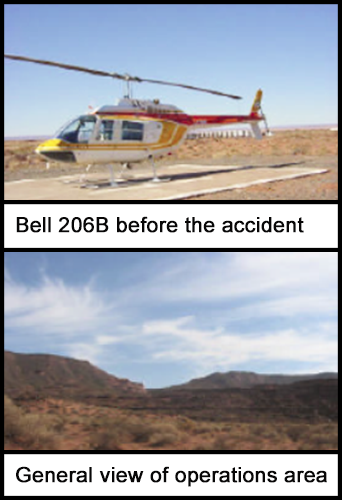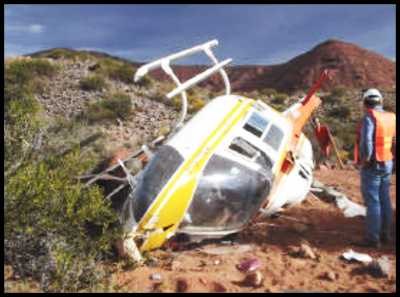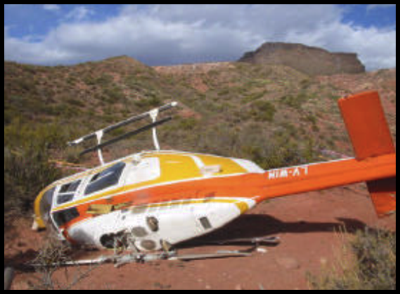-
What happened?
A helicopter was contracted to lift equipment in and out of inaccessible terrain (hills, escarpments and canyons).
Weather conditions were: visibility > 8km, winds 10 knots, temperature 30 - 35°C.
While flying at approximately 3000 feet (914 metres), the pilot lost control and crashed.
He was lucky to suffer only minor injuries, although he was not wearing a helmet. The helicopter was destroyed.

-
Why did it happen?
The helicopter was not adapted for this task. Control was lost due to excessive power demands and other factors:
Hostile environmental conditions:
- high altitude
- turbulent winds from the left
- high external temperatures
Deficient equipment:
- poor standard of equipment for lifting operations, not adapted to lifting tasks in mountainous regions
Lack of knowledge / operations support:
- The load was not dropped when control was lost
- The weight of the helicopter was close to limits (1370kg actual v 1380kg limit)
- weak operational support of the helicopter contractor (no procedures, no incident reporting)
- lack of knowledge about loss of tail rotor efficiency

-
What did they learn?
Reinforce technical specifications to involve logistics experts in choosing the equipment during calls for tender.
Implement pre-selection audits to determine operator technical capacities.
For underslung loads lifted in hostile environments, the weight must be limited at -20% of the maximum weight authorised by the flight manual.
Verify functioning of hook slings during refuelling operations.
Pilots must wear aviation helmets when carrying underslung loads.
Affiliates should ensure that insurance covers for civil damages.

-
Ask yourself or your crew
What actions could have been taken?
Have you ever been in a similar situation? What went wrong?
Should you feel that you do not have the technical abilities to complete the task, who do you communicate this to?
What is your role in ensuring that the equipment we use is adapted for the task?
How do we KNOW this will not happen to us?

Add to homescreen
Content name
Select existing category:
Content name
New collection
Edit collection
What happened?
A helicopter was contracted to lift equipment in and out of inaccessible terrain (hills, escarpments and canyons).
Weather conditions were: visibility > 8km, winds 10 knots, temperature 30 - 35°C.
While flying at approximately 3000 feet (914 metres), the pilot lost control and crashed.
He was lucky to suffer only minor injuries, although he was not wearing a helmet. The helicopter was destroyed.

Why did it happen?
The helicopter was not adapted for this task. Control was lost due to excessive power demands and other factors:
Hostile environmental conditions:
- high altitude
- turbulent winds from the left
- high external temperatures
Deficient equipment:
- poor standard of equipment for lifting operations, not adapted to lifting tasks in mountainous regions
Lack of knowledge / operations support:
- The load was not dropped when control was lost
- The weight of the helicopter was close to limits (1370kg actual v 1380kg limit)
- weak operational support of the helicopter contractor (no procedures, no incident reporting)
- lack of knowledge about loss of tail rotor efficiency

What did they learn?
Reinforce technical specifications to involve logistics experts in choosing the equipment during calls for tender.
Implement pre-selection audits to determine operator technical capacities.
For underslung loads lifted in hostile environments, the weight must be limited at -20% of the maximum weight authorised by the flight manual.
Verify functioning of hook slings during refuelling operations.
Pilots must wear aviation helmets when carrying underslung loads.
Affiliates should ensure that insurance covers for civil damages.

Ask yourself or your crew
What actions could have been taken?
Have you ever been in a similar situation? What went wrong?
Should you feel that you do not have the technical abilities to complete the task, who do you communicate this to?
What is your role in ensuring that the equipment we use is adapted for the task?
How do we KNOW this will not happen to us?
While flying at 3000 feet altitude, a helicopter pilot lost control and crashed. He was lucky to suffer minor injuries, although he was not wearing a hat. The helicopter was destroyed.










